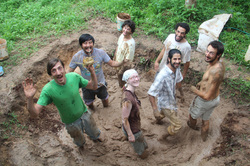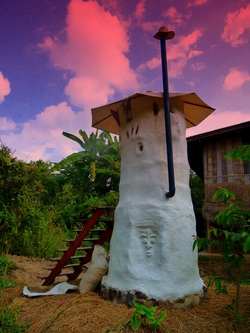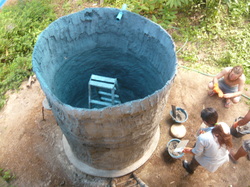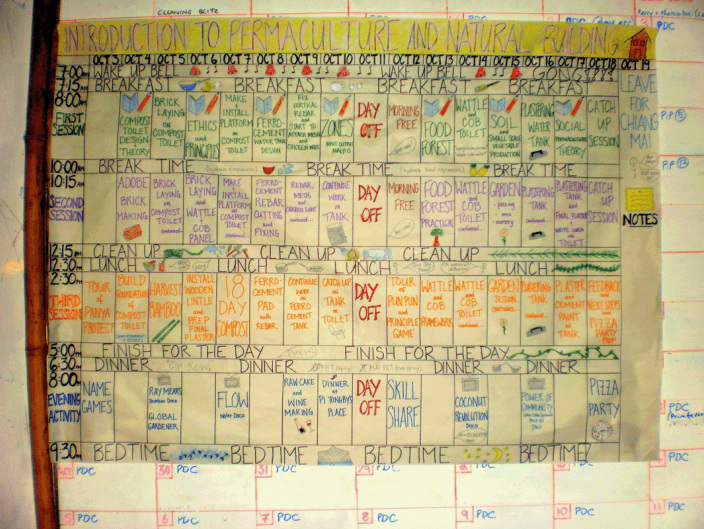Analyse and Assess

- It's been a very interesting and exciting process and i feel I've been pushing my edges in all directions.
Matt and I had been discussing the idea of co-teaching a course/workshop for several months and finally fixed the date for early October.
We both wanted to design a large amount of hands-on experiential learning as well as a solid grounding in the ethics and principles of permaculture into the course. We wanted course participants to leave feeling pumped and empowered to start applying the permaculture principles to their daily lives and to start using and enjoying their newly acquired skills.
The two main projects (ferrocement tank and Composting toilet) were decided upon partly because they were much needed at the project and partly because they were projects that excited Matt and I as well as being skills that we felt could potentially be very useful to course participants.
The Compost Toilet

The Compost toilet was built from Adobe blocks and wattle and cob with a concrete and stone foundation.
This way we managed to combine a number of different building techniques to produce a functional innovative and aesthetically pleasing structure. Building the toilet from a wide range of materials also meant that we were able to teach several different construction techniques.
I consider composting toilets and other sustainable techniques for processing our “humanure” to be of paramount importance in humanity's slow journey into a more sustainable and mindful future.
One of the first steps is trying to educate people to change their paradigm from one of treating “humanure as a waste substance – to be quickly flushed away and forgotten*- to one where we can learn to appreciate the intrinsic value and embodied energy of such substances and learn how to convert them into prime compost which can in-turn help to produce delicious and nutritious fruit and vegetables.
I think it's key that people become more mindful of the true value of water and it's potentially increasing scarcity in the coming years /decades and are educated about ways of reducing their usage and finding alternatives to wasteful practices such as using conventional flush toilets.
This way we managed to combine a number of different building techniques to produce a functional innovative and aesthetically pleasing structure. Building the toilet from a wide range of materials also meant that we were able to teach several different construction techniques.
I consider composting toilets and other sustainable techniques for processing our “humanure” to be of paramount importance in humanity's slow journey into a more sustainable and mindful future.
One of the first steps is trying to educate people to change their paradigm from one of treating “humanure as a waste substance – to be quickly flushed away and forgotten*- to one where we can learn to appreciate the intrinsic value and embodied energy of such substances and learn how to convert them into prime compost which can in-turn help to produce delicious and nutritious fruit and vegetables.
- *When we use conventional toilets in most developed countries we are collectively using millions of litres of clean drinking water to flush away our “turds” and then spending millions in taxes to treat the water again before it's released back into the rivers. Often treated water contains large amounts of chemicals which are added to the water at the treatment plants in order to “clean” it.
I think it's key that people become more mindful of the true value of water and it's potentially increasing scarcity in the coming years /decades and are educated about ways of reducing their usage and finding alternatives to wasteful practices such as using conventional flush toilets.
- Matt and I had both been inspired to build a compost toilet in this “rocket style” after having seen the toilet at our neighbors place (Pun Pun community; www.punpun.org). We went and looked at the toilet at Pun Pun and also checked out are other neighbor Ryan's toilet taking certain elements from each design that we thought we'd like to incorporate into our design. For example we liked the roof at Ryan's place; it was a simple beach parasol. So we bought a nice second-hand canvas parasol from a supplier in Chiang Mai.
We liked the stone foundations at the pun pun toilet and based a lot of our toilets height measurements from their toilet. As I said before our main inspiration for building this style of toilet stemmed from looking at pun puns toilet.
- Matt and I have been involved with the construction of several other compost toilets in Thailand and I feel that I have a good grounding in the theory behind a number of different composting toilet techniques and felt confident and inspired to transmit this knowledge to others as one of the course projects.
- We liked the idea of combining a number of different construction/natural building techniques into the design partly to diversify the skills learned by course participants and partly for practical reasons e.g. The course was at the end of the wet season and drying larger quantities of Adobe bricks was impractical, otherwise we might have considered building the whole structure from Adobe.
- Buildings in the tropics are often attacked by termites so we usually build with concrete foundations to prevent the termites from entering the walls.
We are lucky to have a local creek not far from our project, which contains a great many rocks which we occasionally harvest for building projects. Combining rocks of different sizes with the concrete helps to reinforce the foundations, economises on the amount of cement sand and gravel we have to use and also produces a much more aesthetically pleasing result than concrete alone.
- Adobe blocks have been used as a building material by indigenous cultures in Mexico and the Americas for centuries and can be used to create solid, load-bearing walls and columns.
Adobe is made from a mixture of screened sand, clay, water and a binding material such as chopped straw, rice husks, saw-dust, coconut fibre etc. The materials are combined (we usually stamp around on it in a mud-pit with a group of people) and mixed using as little water as is practically possible (the more water you put in the more has to come out during the drying process. If a lot of water has to come out of the bricks the clay will contract causing cracks).
The mix is then pressed into a mould (ours produces four bricks at a time), which, when lifted up will produce the wet Adobe blocks, the blocks then have to be dried which can take anything from a few days to a couple of weeks depending on the climate.
We used Adobe blocks that we'd prepared in advance in order to have sufficient drying time before the course began.
We built the bottom half (humanure/compost collection chamber) of the toilet from the adobe blocks with a small section of wattle and cob for easy removal of composted material. The Adobe provided a good load bearing structure for the wooden floor of the toilet to rest on.
- We used a technique called wattle and cob for the upper portion of the toilet. Wattle and cob is a fusion of two more well known natural building techniques; Cob, which uses a clay, sand and straw mix to produce small cob-shaped blocks and Wattle and Daub a traditional English building technique (used to make Tudor houses) where a clay/sand plaster mix is daubed onto a wall of woven hazel or willow. We make wattle and cob by first making a lattice style wall from Bamboo, and draping cob over the horizontal pieces of bamboo and wrapping the Cob around the uprights. Wattle and cob is a very versatile and creative technique, making it easy to produce very beautiful and funky results.
The Ferrocement Tank

- The ferrocement water tank was designed to harvest rain water to provide the Panya community with an extra 3000 litres of drinking water. Ferrocement is a very economic, versatile and easy to learn construction technique. During the course we taught participants every aspect of building a ferrocement tank and constructed one together in practical work-sessions over 2 weeks.
- Ferrocement is made by creating a framework of closely spaced steel rods (rebar) connected to heavy duty wire mesh and reinforced with chicken-wire, onto this framework a cement and sand mortar is plastered. It can create very strong and resilient structures with minimal input of cement. It can be used to make water-tanks, Urns, walls, etc.
- Matt and I are both passionate about increasing water security and wanted to focus that passion into a practical project during the workshop. We're both experienced at building ferrocement tanks having built Two other tanks in the past; One here at Panya and one in the south of Thailand.
- We decided to situate this tank next to the other ferrocement tank that we have on site. The tanks collect rainwater from “the cottage” one of the few buildings we have on site suitable for rainwater collection due to it's metal roof.
An Introduction To Permaculture

We wanted to integrate a permaculture introduction course into the workshop in order to give the students a good grounding in the theory of permaculture.
We generally taught a theory class every second day in the morning session and took it in turns to teach each class. The classes/subjects we covered in the introduction included:
We generally taught a theory class every second day in the morning session and took it in turns to teach each class. The classes/subjects we covered in the introduction included:
- Compost toilet design and theory; Matt and I shared this class, with Matt teaching the design aspects of composting toilets. Followed by me explaining the theory behind composting toilets .
- Ethics and Principles of Permaculture; This class was taught in two parts, one in the morning at panya focusing mainly on the Ethics of permaculture; Earth-care, People care and Fair-share, and one session a few days later at Pun Pun where we played a game matching up the principles of permaculture to their “common sayings”.
- Ferrocement Water-tank design; Matt taught this class. During the class he explained the principles of designing a ferrocement tank and the technical details of working with ferrocement.
- Zones / input – output analysis; Matt taught the zones class and I taught the input/output analysis.
The zones class was an interactive session where students learned to think about the inter-placement of elements when designing a fictional farm or project. For the input/output analysis I used the “chicken analogy”, which, using a chicken as an example, helps students to grasp and start thinking about the inputs and outputs of certain elements within a system and start applying the permaculture principles.
- Food Forests; I taught the food forest class and covered the basic theory of forest ecology, forest layers and succession before explaining about the concepts of biomimicry, overstacking, guilds and how to go about designing and creating a food-forest.
- Soil / small-scale veg production; I taught this class and explained to the students the basics of designing and creating small-scale vegetable gardens, soil fertility and how to maintain and improve it the benefits and advantages of growing your own food, companion planting etc.
- Soil / small-scale veg production; I taught this class and explained to the students the basics of designing and creating small-scale vegetable gardens, soil fertility and how to maintain and improve it the benefits and advantages of growing your own food, companion planting etc.
- Food Forests; I taught the food forest class and covered the basic theory of forest ecology, forest layers and succession before explaining about the concepts of biomimicry, overstacking, guilds and how to go about designing and creating a food-forest.
- Social permaculture; I taught this class and started with a short guided meditation “Gaia earth-healing session” encouraging students to become more aware of their own energies and how they can potentially affect/nurture others. Followed by an interactive (the blanket/boat) game which was designed to promote group cohesion, trust and dynamics.
- Social permaculture; I taught this class and started with a short guided meditation “Gaia earth-healing session” encouraging students to become more aware of their own energies and how they can potentially affect/nurture others. Followed by an interactive (the blanket/boat) game which was designed to promote group cohesion, trust and dynamics.
- 18-day Berkley Compost; This class wasn't originally planned in the course schedule, but after constructing the berkley 18 day compost pile with the students we realised that they'd benefit greatly by having a more in depth theory session about how compost works and why we like Berkley compost so much over other composting methods. Having designed in a few catch-up sessions into the course we were able to squeeze this session in quite nicely.
